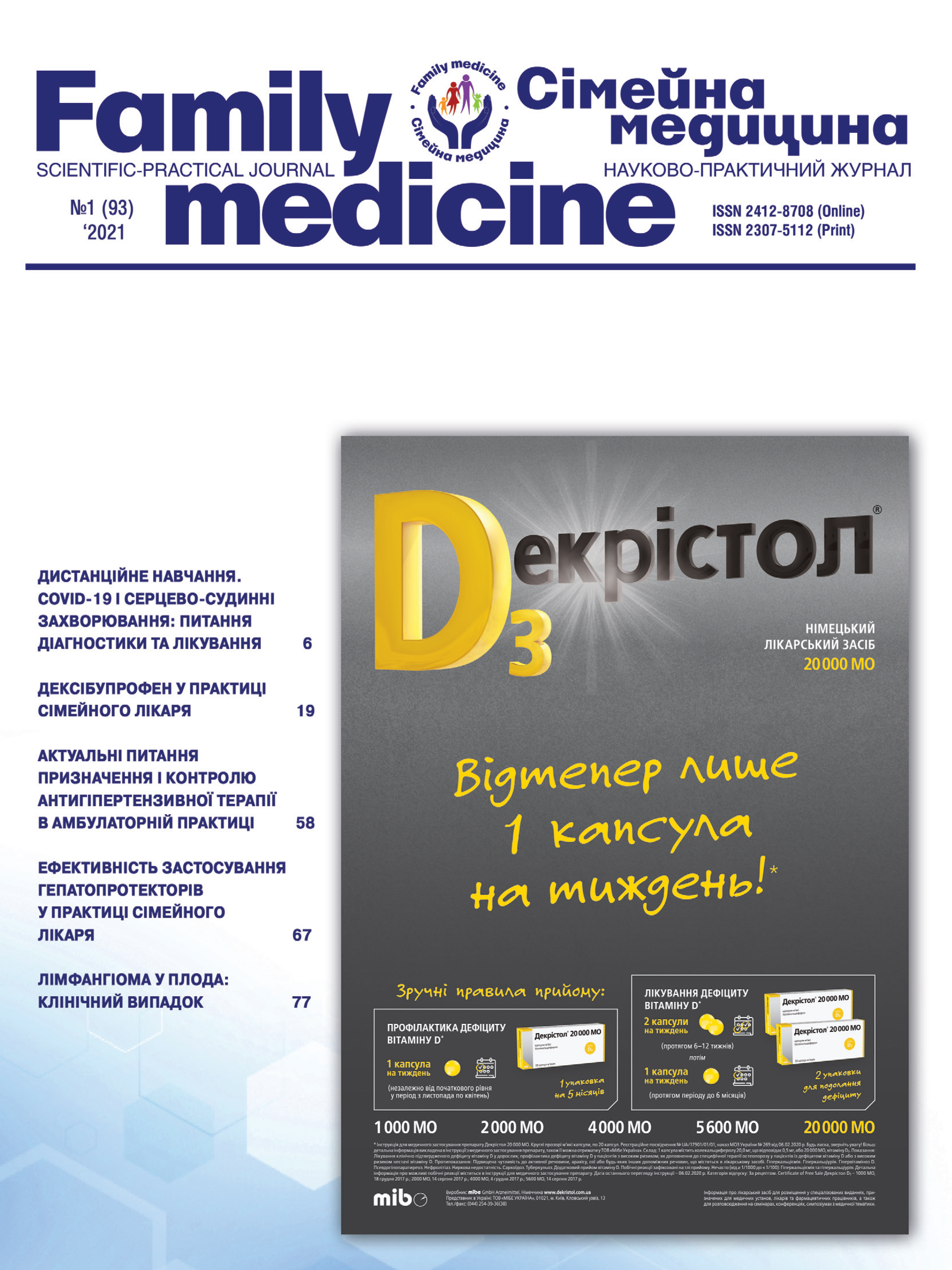The Spread of Thyroid Diseases and the Algorithm for Diagnosing Thyroid Dysfunction
##plugins.themes.bootstrap3.article.main##
Abstract
Diseases of the thyroid gland are considered one of the most common endocrinopathies. This is due to the influence of ecologically unfavorable environmental factors, bad habits, malnutrition, comorbid conditions and genetic predisposition. Determining an algorithm for diagnosing thyroid dysfunction for the timely detection of diseases is expedient and relevant.
The objective: to analyze the state of the spread of thyroid diseases among the population of the Kiev region and to determine the diagnostic algorithm based on the identification of the main clinical syndromes of thyroid dysfunction.
Materials and methods. Among the adult population of the Kiev region, a high level of morbidity and spread of thyroid diseases is recorded. The increase in the number of cases occurred, first of all, due to the newly diagnosed patients with hypothyroidism, thyroiditis. The manifestation of most diseases is associated with the development of thyroid dysfunction. Under the hypothyroidism one can observe and diagnose the following: a syndrome of neuropsychiatric disorders with slowing down of motor activity, decrease in cognitive functions; syndrome of vegetative-trophic disorders with cutaneous mucinosis, polyneuropathy; syndrome of cardiovascular changes with decreased myocardial contractility, slow blood flow, progressive development of atherosclerosis; anemic syndrome; digestive tract syndrome with impaired motor and secretory functions of the gastrointestinal tract; syndrome of hormonal disorders with decreased secretion of thyroid hormones, especially T4, increased levels of TSH (in primary hypothyroidism) or decreased TSH (in secondary and tertiary).
Results. Thyrotoxicosis in patients is determined by an enlarged thyroid gland with the development of: thyrotoxic cardiomyopathy and systolic arterial hypertension; thyrotoxic encephalopathy, syndrome of neuropsychiatric disorders with a predominance of excitation processes, vascular dysfunction; thyrotoxic ophthalmopathy, ectodermal disorders syndrome along with a decrease in TSH production and an increase in the level of free fractions T4, T3.
Conclusions. The algorithm for diagnosing hypofunction and hyperfunction of the thyroid gland provides for: clarification of complaints and anamnesis data, examination of the patient, additional laboratory and instrumental examination, which includes the study of the thyroid status, possible autoaggression, analysis of metabolic processes, assessment of pathomorphological changes in the thyroid gland.
##plugins.themes.bootstrap3.article.details##

This work is licensed under a Creative Commons Attribution 4.0 International License.
Authors retain the copyright and grant the journal the first publication of original scientific articles under the Creative Commons Attribution 4.0 International License, which allows others to distribute work with acknowledgment of authorship and first publication in this journal.
References
Макаров ИВ. Биосинтез, секреция, метаболизм и механизм действия тиреоидных гормонов. Методы исследования щитовидной железы. В: Караченцев ЮИ, Казаков АВ, Кравчун НА, Ильина ИМ, редакторы. 100 избранных лекций по эндокринологии (второй выпуск). Харьков: 2014;486–98.
Тронько НД, Большова ЕВ, редакторы. Заболевания щитовидной железы. В: Настольная книга врача-эндокринолога: справочник врача. Киев: ООО Библиотека «Здоровье Украины»; 2018;40–72.
Шкала ЛВ. Сучасна тиреоїдологія: монографія. Луганськ: ДЗ «Луганський державний медичний університет»; 2014. 156 с.
Livingston Edward H. Subclinical Hypothyroidism. JAMA. 2019 Jul; 322(2):180. DOI:10.1001/jama.2019.9508
Mubashir Alam K, Tasnim Ahsan, Urooj Lal R, Rukhshanda Jabeen, Saad Farouq. Subclinical Hypothyroidism: Frequency, clinical presentations and treatment indications. Pak. J. Med. Sci. 2017 Jul-Aug;33(4):818–22. DOI: 10.12669/pjms.334.12921
Razvi S, Ingoe L, Keeka G, Oates C, McMillan C, Weaver JU. The beneficial effect of L-thyroxine on cardiovascular risk factors, endothelial function, and quality of life in subclinical hypothyroidism: randomized, crossover trial. J. Clin. Endocrinol. Metab. 2007 May; 92(5):1715–23. DOI: 10.1210/jc.2006-1869
Вербовой АФ, Шаронова ЛА. Синдром гипотиреоза: лекция. Журнал для непрерывного образования врачей. Эндокринология: новости, мнения, обучение. 2015;4:71–5.
Генделека ГФ, Генделека АН. Затруднения диагностики и терапевтическая тактика при аутоиммунном полигландулярном синдроме 2-го типа. Клиническое наблюдение. Міжнародний ендокринологічний журн. 2018;14(1):99–102.
Генделека ГФ. Аутоиммунный синдром перекреста (overlap-синдром) при заболеваниях щитовидной железы – terra incognita тиреоидологии. Міжнародний ендокринологічний журн. 2016; 2(74):140–51.
Бобирьова ЛЄ, Муравльова АВ, Городинська ОЮ. Автоімунний тиреоїдит: особливості клінічного перебігу та принципи диференційованої терапії. Міжнародний ендокринологічний журн. 2014;1(57):17–24.
Власенко МВ. Аутоиммунный тиреоидит у подростков. В: Караченцев ЮИ, Казаков АВ, Кравчун НА, Ильина ИМ, редакторы. 100 избранных лекций по эндокринологии. Харьков; 2009. с. 372–8.
Пашенцева АВ, Вербовой АФ. Диффузный токсический зоб. Клиническая медицина. 2017; 95(9):780–8. DOI: 10.18821/0023-2149-2017-95-9-780-788
Макар РД. Функциональная автономия щитовидной железы: современное состояние проблемы: В: Караченцев ЮИ, Казаков АВ, Кравчун НА, Ильина ИМ, редакторы. 100 избранных лекций по эндокринологии. Харьков; 2009. с. 446–52.
Петунина НА, Мартиросян НС, Трухина ЛВ. Синдром тиреотоксикоза. Подходы к диагностике и лечению. Эндокринология. 2012;10(1):20–4.
Кулабухова ИС, Елисеева ЛН. Состояние периферического кровотока у больных дуффузным токсическим зобом в зависимости от уровня компенсации тиреоидного статуса. Казанский медицинский журн. 2013;94(6):804–7. DOI: 10.17816/KMJ1794
Фархутдинова ЛМ, Бруй АЛ. Возрастные особенности диффузного токсического зоба: случай из практики. Архив внутренней медицины. 2015;(3):40–4. DOI: 10.20514/2226-6704-2015-0-3-40-44
Аристархов РВ. Об особенностях течения подострого тиреоидита де Кервена и современных методах лечения. В: Караченцев ЮИ, Казаков АВ, Кравчун НА, Ильина ИМ, редакторы. 100 избранных лекций по эндокринологии (второй выпуск). Харьков; 2014. с. 356–62.





